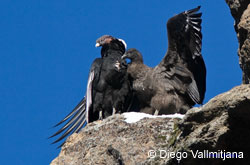The cherry on the cake of the January 2008 flights was thermalling with hordes of condors: these are the young that practise flight school in groups of 5 to 10 with one or two adults who teach them the soaring manoeuvres and thermal centering.
We were lucky meeting Christian Höller and Diego Vallmitjana, local paraglider expert pilots and directors of a film that should be released shortly, describing the life and the flight characteristics of the Andean Condor. The trailer can be viewed in streaming or downloaded here. Extraordinary pictures not to be missed!


For that reason, the female lays an egg only every two years. And when the flying age arrives, the adults organize collective courses during which the instructors (not necessarily the parents) take a group of youngsters to work soaring for hours. And when a glider pilot is lucky enough to meet with this “heap of feathers”, it is a true treat to play with them. It is easy to distinguish among them, the young being uniformly brown (and remaining brown until fully mature) and have a “jerky”, poorly organized flight, flapping paws down, whereas the adults are black and white with a white flange around the neck, and have a majestic flight in an elegant and linear position. More details at the Smithsonian National Zoological Park.
The Cerro La Buitrera is characterized by thousands of holes which the condors use to rest. Contrary to common knowledge, the condor is the absolute opposite of a lonely and shy bird! It only asks for one thing: to be in good company and to fly for pleasure, high and far. As we, glider pilots, do!
Appointment next November to continue research using the glider. And hoping to discover even more secrets….
